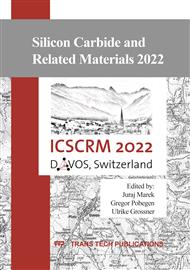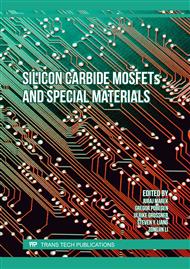p.119
p.127
p.135
p.141
p.147
p.153
p.159
p.165
p.171
High Mobility Silicon Dioxide Layers on 4H-SiC Deposited by Means of Atomic Layer Deposition
Abstract:
A study on the impact of different growth and deposition techniques on the reliability of silicon dioxide (SiO2) layers on silicon carbide (SiC) metal-oxide-semiconductor capacitors (MOSCAPs) is presented and compared to channel mobilities that were extracted from lateral metal-oxide-semiconductor field-effect transistors (LMOSFETs). Oxide layers were formed using atomic layer deposition (ALD), low pressure chemical vapour deposition (LPCVD) and direct thermal growth, including post-deposition anneals (PDAs) in nitrious oxide and forming gas (FG) for the ALD-and LPCVD-deposited oxides. Electrical characterisation results at elevated temperatures show that a PDA in FG leads to the highest average breakdown electric field of 10.08 MV/cm, outperforming all other device splits. Time-dependent dielectric breakdown (TDDB) results showed that the time to failure of 63% of the investigated samples at 9MV/cm in the FG-annealed samples was about 50% higher than in LPCVD-deposited oxides that had undergone an N2O PDA. Channel mobilities of the FG-treated samples averaged about three to four times higher than in other datasets, showing excellent peak field-effect mobilities of 60 cm2/V.s and 108 cm2/V.s at room temperature and 175°C, respectively.
Info:
Periodical:
Pages:
147-151
Citation:
Online since:
May 2023
Permissions:
Share:
Citation:



